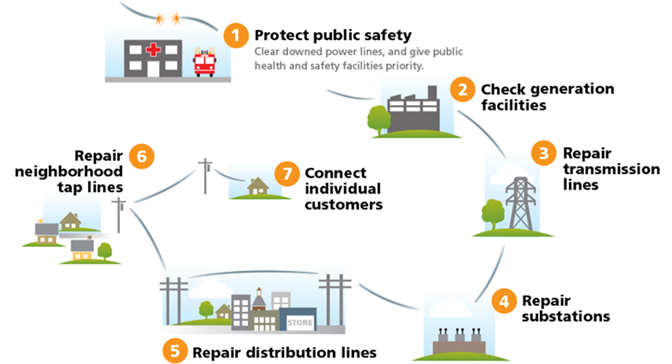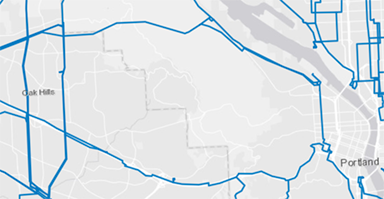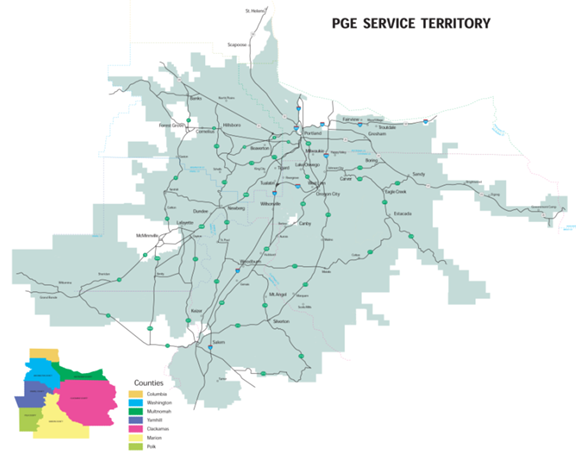How does our power grid work?

by Vicky Siah
Electricity provides the energy for many of our daily activities—from each flick of a light switch to charging our devices, we rely on the power grid to live efficiently. Portland General Electric (PGE) is the electricity provider for Cedar Mill, and through their chain model of infrastructure, they ensure that we have consistent access to power.
While we commonly associate electricity with power plants, moving energy from PGE’s generation facilities to individual houses and businesses is considerably more complex. PGE’s energy distribution can be visualized as a web of facilities, lines, and stations: power plants are the hub of generation, but other points of infrastructure make energy transport possible.

Plants to transmission lines
To begin the journey from plant to home, PGE’s 16 facilities extract energy from natural resources and direct it to smaller transmission lines. These lines act as the first mode of transport—they move high voltage energy straight from the plants—allowing energy to travel rapidly to customers.
Transmissions lines to substations
Transmission lines, in turn, branch out to substations that allow energy to be further distributed to areas. Each substation converts the high voltage to a lower, usable level, and directs it towards smaller feeder lines.
Substations to feeder lines
Feeder lines serve a few thousand customers apiece and branch into tap lines.
Feeder lines to tap lines
Tap lines go down individual streets and provide power to neighborhoods. In Cedar Mill, these tap lines typically serve 20 to 30 homes per line.
Tap lines to service drop or service lateral
These tap lines reach individual homes and businesses through a direct connecting line. Service drops are the overhead connections from a tap line to a building. A service lateral is an underground connection.
Oregon has experienced significant weather changes recently, and these changes have raised concerns about power outages in homes and businesses. In light of recent heat waves, Cedar Mill News conducted research on why these outages happen, how PGE works to fix them, and how residents can prepare for power disruptions.

Why outages happen
Outages can occur due to equipment malfunction or a damaged power line, and the size of the affected population depends on where the issue occurs. When an outage happens, PGE takes a top-down approach—they first check their generation facilities before proceeding to transmission lines, substations, feeder, and tap lines. If they discover a facility issue, they attempt to mitigate the power outage by switching to other resources, restoring power to consumers quickly.
According to the PGE website, the highest percentages of outages are related to feeder pole disruptions, which can be caused by storms, car crashes, and wildlife. These outages can affect many neighborhoods. Alternatively, only single houses or businesses will experience the outage if a service drop or service lateral is damaged. PGE states that this small-scale form of outage is “the most difficult and time-consuming”—given a service line issue, PGE must send crews to the affected building to fix it.
During wildfire season, PGE may enact additional power shutoffs. Andrea Platt, Principal Communications Consultant at PGE, defines these Public Safety Public Shutoffs (PSPS) as “a last resort measure where we turn off power to protect public safety.” In preparation for warmer months, PGE has outlined areas that have a statistically higher risk of power shutoffs, factoring temperatures, humidity, fire reports, and environment. Cedar Mill is near Portland West Hills (a designated high-risk zone), and Platt encourages Cedar Mill residents to make an outage plan. “It’s quite possible that wildfires could spread to non-PSPS regions,” said Platt. “It’s a good idea for everyone to be prepared.”
Especially in the summer, when the risk of outages is high, PGE takes precautions to maintain the power supply. Faced with the recent heat waves, Platt says that PGE prepared to meet a high demand of service. “We took steps to ensure the system was ready and that crews were ready,” she said.
How PGE restores power
PGE’s system is not limited to the physical infrastructure, and PGE’s crews consist of employees with a variety of specializations. Alongside power plant and line workers, crews who manage the command center, dispatch, road clearing, tree moving, and other operations are equally necessary. PGE’s teams work to bring back electricity quickly and safely, each playing a crucial role in the process. Together, they maintain the public’s connection to power sources and provide valuable insight to how PGE functions.

How residents can prepare for power disruptions
PGE recommends that residents prepare for outages by creating an outage kit and plan. These kits may consist of flashlights, batteries, battery-powered or hand-held radios and fans, bottled water, ice packs, and other supplies. Furthermore, residents should keep a list of important phone numbers, including the number for PGE customer service (503-228-6322), and update their PGE account information.
The PGE website notes that “summer safety-related outages are different than winter outages,” and residents are advised to consider high temperatures, especially if they reside within a PSPS high-risk zone. Regardless, residents should create an evacuation plan ahead of time to prepare for potential power outages in the summer—they may need to seek shelter—and if residents care for pets, they must ensure that their animals are provided for. Some residents may also consider purchasing a backup generator.
PGE customers who depend on power for medical purposes should enroll in PGE’s Medical Certificate program and inform PGE of their critical need. This program will connect these customers with PGE advisors, who will support them in creating a back-up plan and provide communication during a power outage. Individuals in the Medical Certificate program may be further assisted by agencies and emergency services should an outage occur.
Information for all preparedness plans can be found on the PGE website. Eligibility requirements for the Medical Certificate program and a medical needs brochure can be found on their Powering Medical Equipment page.
PGE continues to work on improvements to the grid to provide more sustainable energy sources and minimize outages.





